Family : Pentatomidae

Text © Prof. Santi Longo

English translation by Mario Beltramini
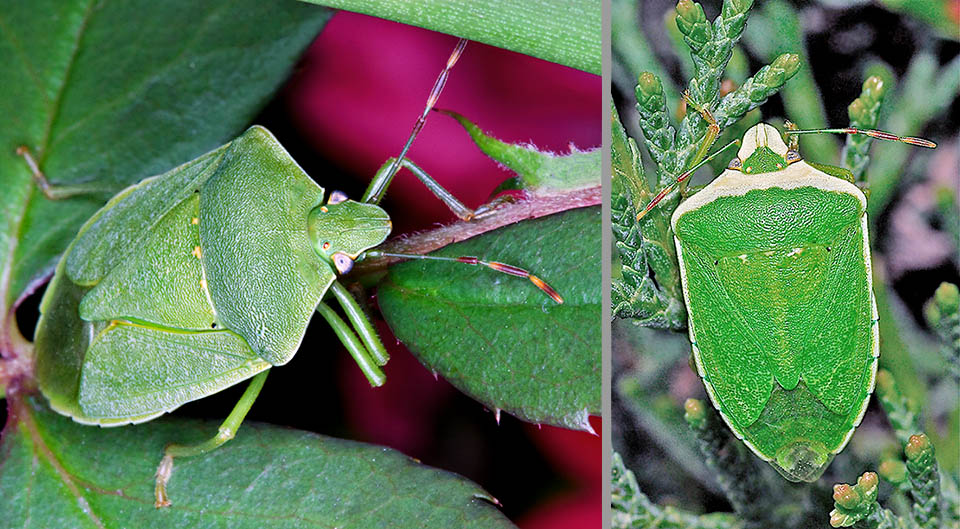
Nezara viridula adults with the three typical clear spots at the base of the scutellum. Left, the form described by Linnaeus and right Nezara viridula torquata, described by Fabricius, with the anterior part to the compound eyes, of the pronotum and the edge of the pinkish cream forewings © Giuseppe Mazza (left) and © Robert Combes (right)
The Southern green stink bug Nezara viridula (Linnaeus, 1758) is a Heteropteran True bug of the family Pentatomidae so called due to the sub pentagonal shape of the body of the about 5.000 species included in it, many of which having lively and metallic liveries.
In the head, besides the compound eyes, are present two simple, or ocelli, eyes.
The antennae are formed by 5 articles, called antennomeres.
The buccal apparatus, of the pungent sucking type, is formed by the long upper lip; by the lower one, or rostrum, fleshy and docciform that hosts the maxillary and mandibular stylets; as well as the hypopharynx associated with the pharyngeal or salivary pump.
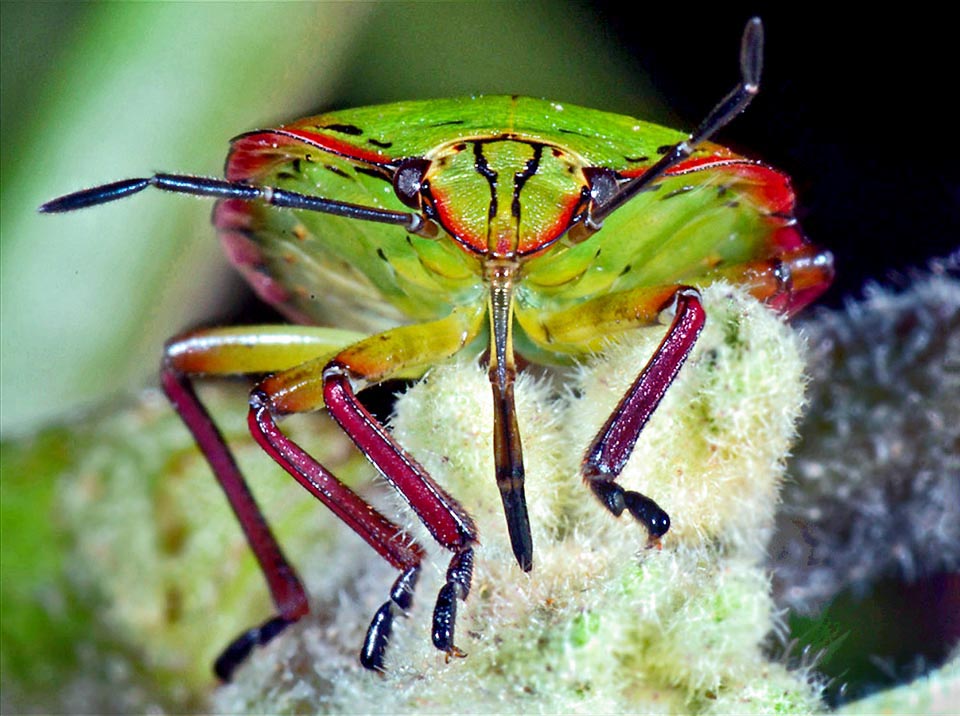
Head with close up of the pungent sucking mouthparts with which it sucks the lymph of the plants. The lower lip, or rostrum, with 4 articles, hosts the buccal stylets © Antonio Pascual Belda
Peculiar characteristic is the presence of repugnatorial glands emitting a pungent odour with which they signal to the predators the unpleasant taste of their body. Many species have a phytophagous diet; relatively few are the zoophagous ones that also prey on other bugs.
The adults of some pentatomids performs more or less long migrations.
The generic name Nezara, created by Amyot & Serville in 1843, comes from the Hebrew terms “azar”, and “nezar” that respectively mean “belt” and “surrounded by a rope”; whilst the specific one, viridula, assigned to the Southern green stink bug by Linnaeus, recalls in Latin the verdant colour of the adults.
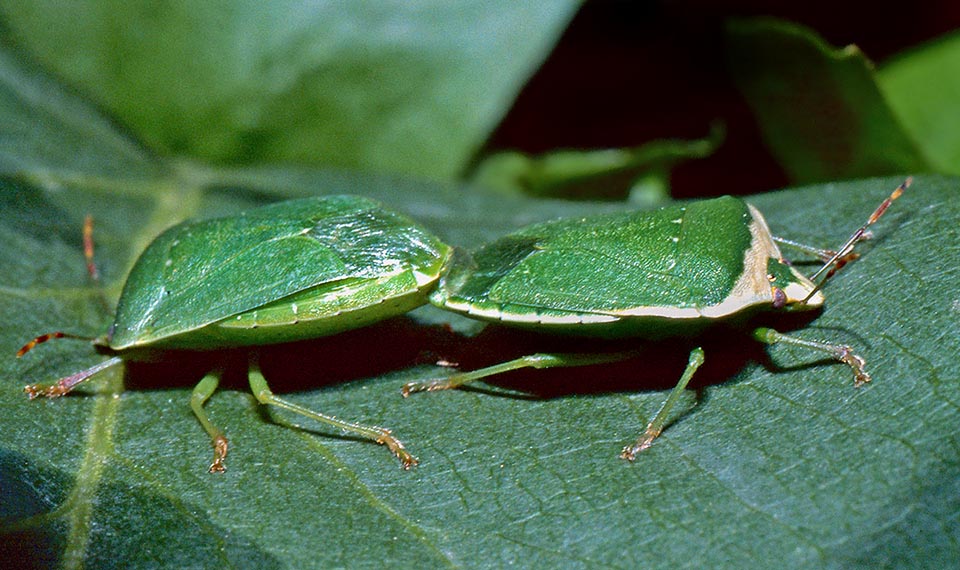
During the mating, that lasts long time in an opposite position, the adults feed themselves moving often on the substratum © Bernard Dupont
Zoogeography
Deemed as original of the Horn of Africa, the species is nowadays cosmopolitan as, since the remote times, has been passively spread with the transport of the host plants by farmers and travellers, in the agricultural zones of the whole world.
Ecology-Habitat
The polyphagous Nezara viridula is able to infest various spontaneous plants and industrial open field cultivations such as tomatoes, cabbages, beets, soy, sunflower, tobacco, maize, rice and sorghum, damages are reported on arboreal plants like citrus and hazelnut, as well as on ornamental and of landscape interest plant.
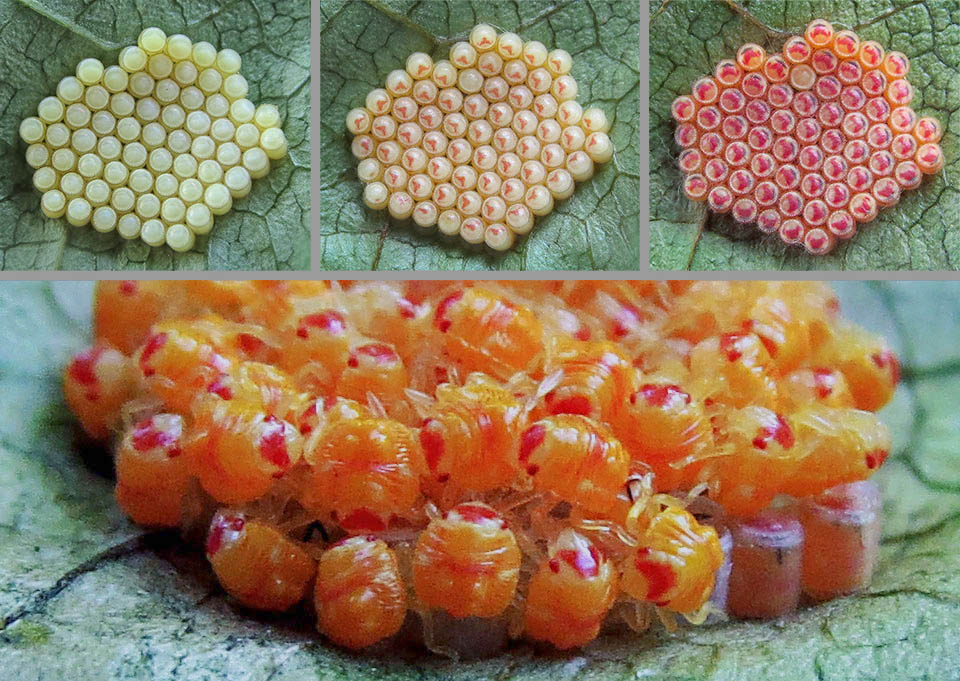
Eggs development stages in the ovations. When just laid these are whitish. Later on, dorsally appears in transparency, the pinkish colour of the embryo that gets more evident just before hatching. Below, in zoomed foreground, the newly born neanids stopped on the empty shells while the exoskeleton hardens up © Nagy Sándor m&m
Morphophysiology
The body of the adults is 14-16 mm long, of pale green or yellowish green colour with three characteristic pale spots at the base of the scutellum, useful for distinguishing them from those of species having macroscopically similar liveries such as Palomena pràsina (Linnaeus, 1761) and Piezodurus lituratus (Fabricius, 1794).
The head has a distinct median lobe and is not covered by the lateral ones. The antennae are green with the distal part of the three distal articles of black colour. Rarely do chromatic variations appear with red integument, less frequent are the dark liveries, green or brown, of the adults destined to winter.
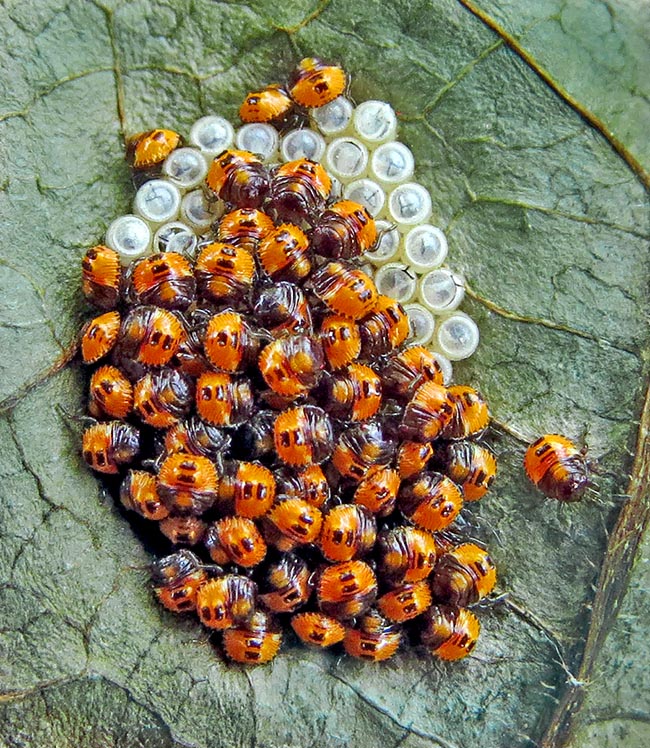
After some hours the tegument becomes harder and the young neanids drift away dispersing on the vegetation © Nagy Sándor m&m
In 1775, Fabricius described the two forms: Nezara viridula smaragdula entirely green and Nezara viridula torquata whose adults have the anterior part to the compound eyes and the pronotum, as well as the edge of the forewings of a more or less pinkish cream colour.
The sub cylindrical eggs measure about 1,4 x 1-1,2 mm; when just laid they are whitish, then they become orange yellow and, when the embryonic development is advanced, the embryo is seen in transparency.
Before hatching they get a light fleshy colour. The chorion is areolar and, in the border of the operculum are present short blunt setuliform formations.
The neanids have no wingtips. The body has colourations varying from reddish yellow to green up to brown.
The first age one’s back, when just freshly shelled from the egg, is yellowish with darker spots close to the sides of the first thoracic segment and on the margins of those of the abdomen.
The thorax back of the second age neanids is of green colour with black or brown small spots.
In the abdomen, that often assumes brown colourings, are present two sub dorsal lines of white and red spots.
The nymphae are usually green and, depending on the age, may present the dorsal part of the thorax of blackish or greenish colour. The remainder of the body is more or less dark green, except a dorsal zone at the centre of the abdomen, presenting two lines of white spots and others, marginal, red, sided towards the interior by a line of white spots.
Ethology-Reproductive Biology
The adults of Nezara viridula, in the temperate climate zones, winter in various shelters: at the base of the plants, among the dry leaves, in the crannies of the bark, in the hedges, etc.
In spring, as soon as the climate allows it, the adults resume their activity and, after feeding, they mate.
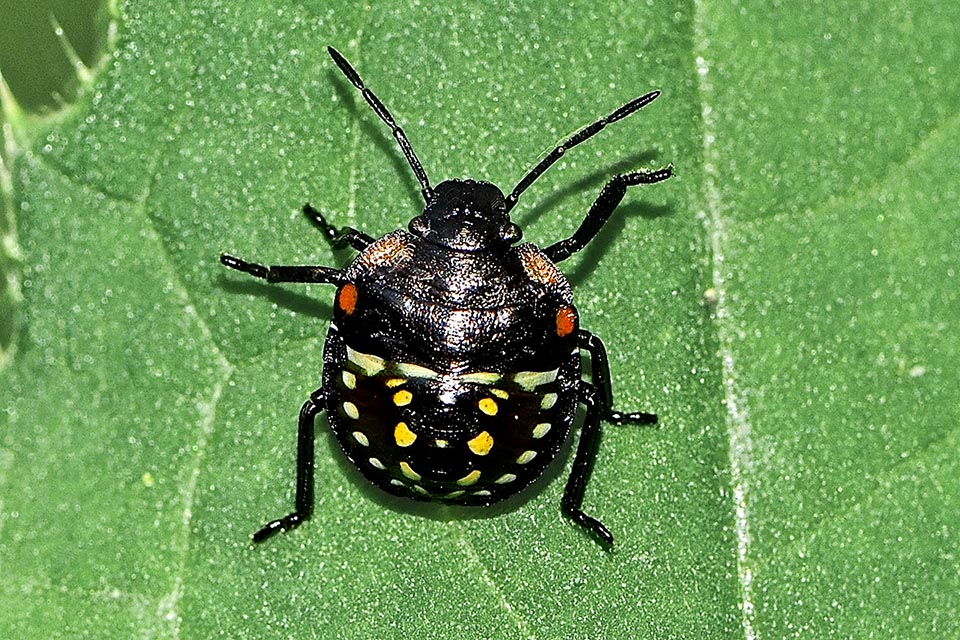
The neanids at the end of the first age often have a very dark tegument on which the spots do stand out © Robert Combes
The females oviposit on the lower pagina of the leaves, on the pods and in other parts of the numerous host plants, herbaceous and arboreal, either spontaneous or cultivated originating the first annual generation.
In relation to the scalarity of the ovipositions and of the hatching of the eggs, usually, are at the same time present in the field the various biological stages of neanid, nymph and adult.
The species tends to be homodynamous and consequently during the year may occur more generations.
Normally in environments having a temperate climate are completed on average two or three biological cycles.
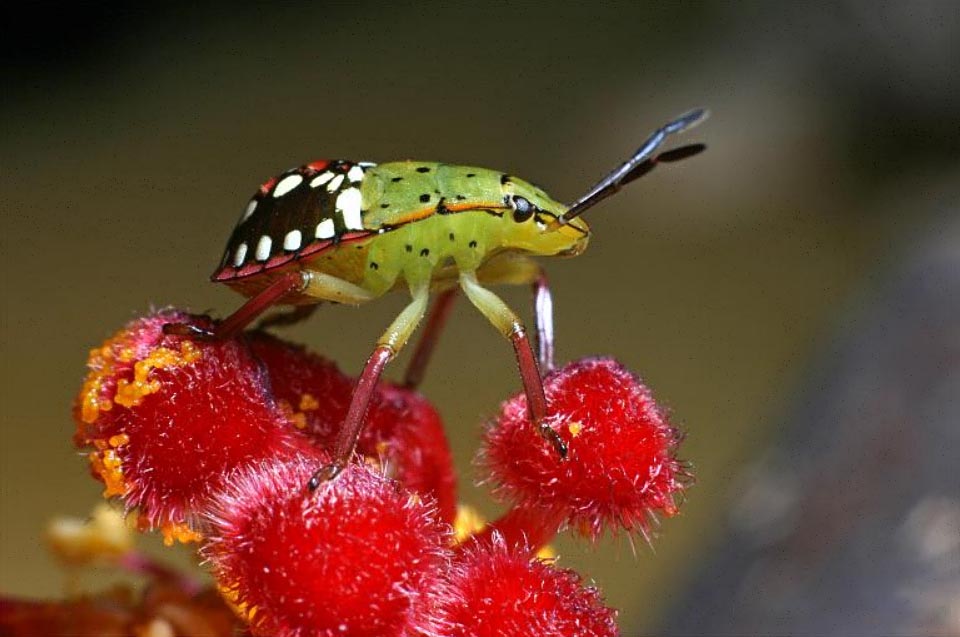
The second age neanids feed on pricking and sucking the humours of numerous plants. The trophic activity is even more intense during the nymphal stages © Leo Weyer
Ordered groups of eggs, called ovations, are laid mostly on the lower pagina of the leaves, less frequently on the upper one or on other plant organs.
The ovations include a variable number of elements, 4 to 114 (more often, 78).
The neanids shell after a 5-10 days incubation and, after having completed five preimaginal stages, in July the adults do appear.
These ones, after having fed for 15-30 days, reach sexual maturity and, during the summer, lay the eggs of the second generation.
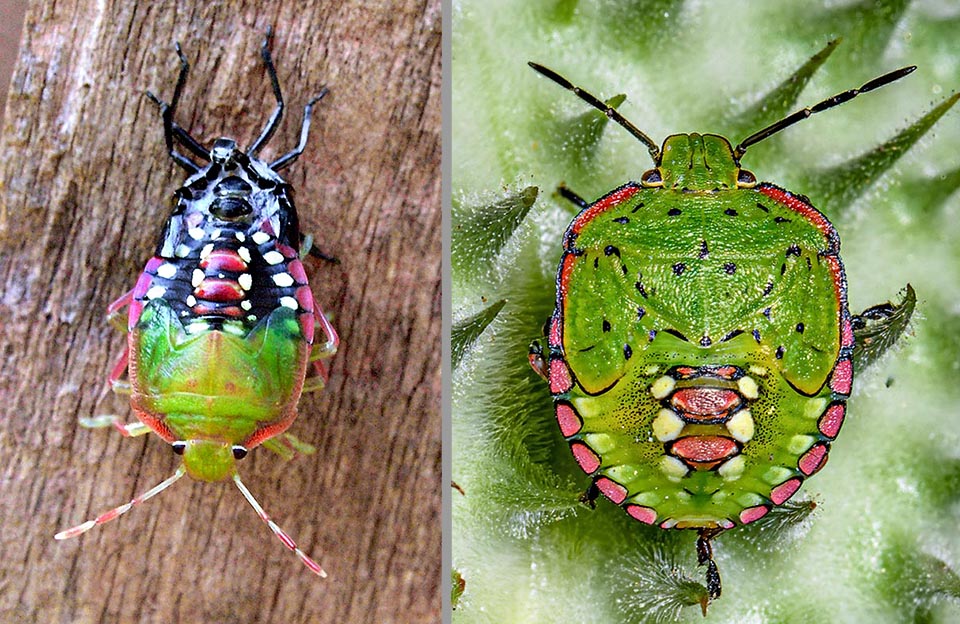
Last age nymph while moulting and specimen now close to the adult stage © John Pitts (left) and © Nitin Chandra (right)
The juvenile forms coming from them cause the main damages to the cultivations of tomato, cotton and soy.
With the feed bites the forming hazelnuts and the pistachios disappear (traumatic abortion) whilst, to the formed fruits they transmit their unpleasant odour, known as “bug odour” that renders them not marketable.
The adults continue their trophic activity until the first cold weather; then they get shelter in order to overcome the winter rigours.
Active parasitoid insects that are unable to significantly reduce the population density of the Pentatomid are some Scelionid Hymenopterans of the genus Telenomus and Encyrtids of the genus Ooencyrtus.
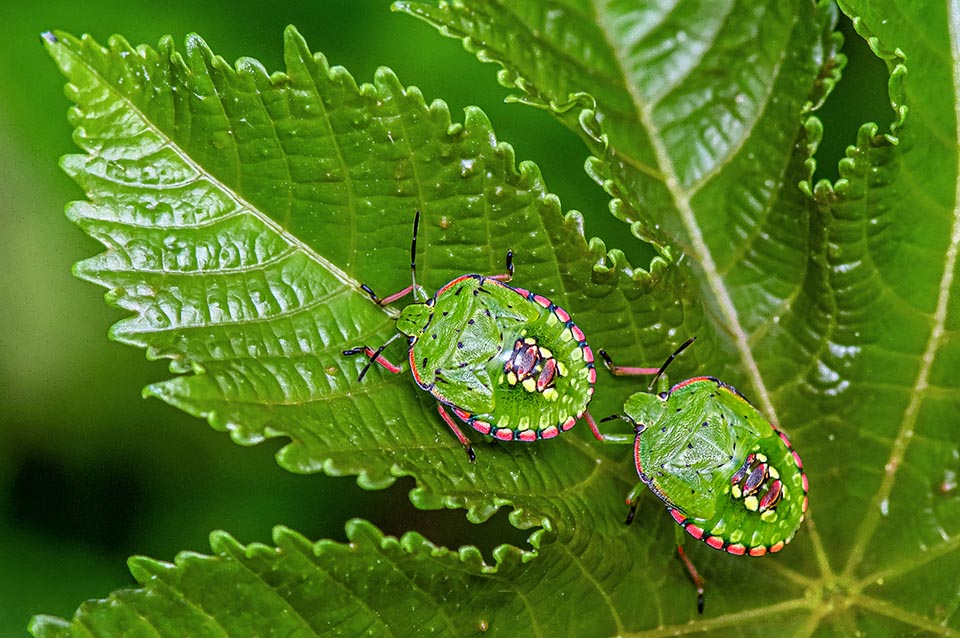
Two nymphae suck a leaf transmitting the unpleasant taste of their repugnatorial glands. The main damages occur to the cultivations of tomato, cotton and soy © Wellington Pracz
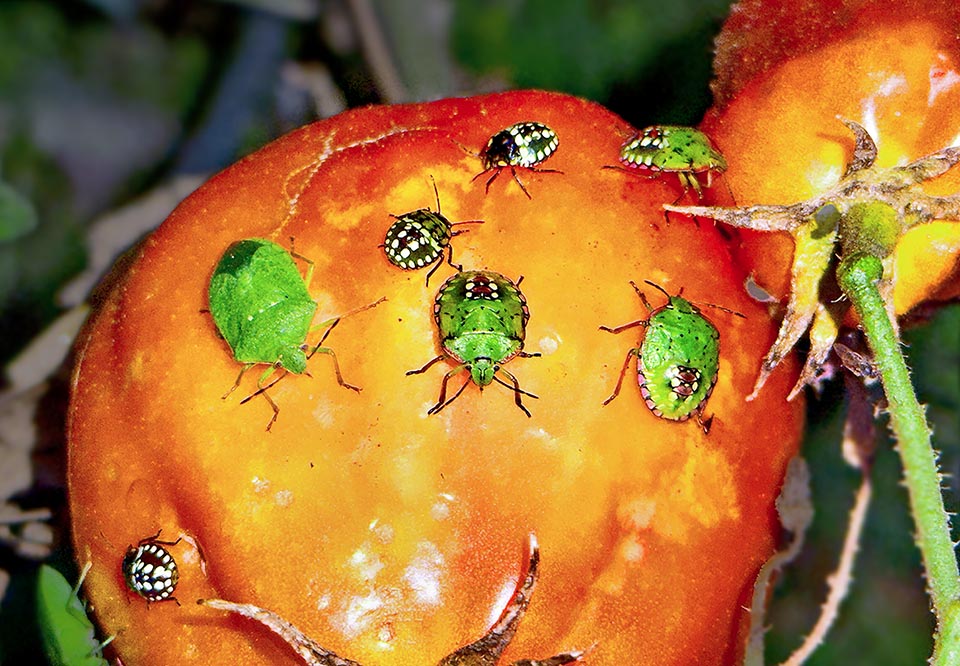
In fact, here are, united, one adult, neanids and nymphae that with their bites cause evident damage to a tomato © Giuseppe Mazza
It has been proven that the plants of Vicia faba and of Phaseolus vulgaris, after the stings of oviposition and of feeding of the Southern green stink bug, release volatile compounds recalling the ooparasitoid Trissolcus basalis that is grown in the biofactories and utilized in biological control programs.
The adults of the Southern green stink bug are parasitized by Tachinid Dipterans of the genus Tricopoda.
Synonyms
Cimex viridula Linnaeus, 1758; Cimex torquatus Fabricius, 1775; Cimex smaragdulus Fabricius 1775.
→ To appreciate the biodiversity of RHINCHOTA or HEMIPTERA click here.
